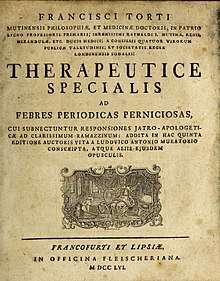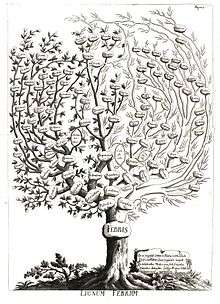Therapeutice Specialis ad Febres Periodicas Perniciosas
 | |
| Author | Francesco Torti |
|---|---|
| Country | Italy |
| Language | Latin |
| Subject | Medicine |
Publication date | 1756 |
The Therapeutice Specialis ad Febres Periodicas Perniciosas (Latin for Special Therapy for Pernicious Fevers) is a book published in 1712 and written by Italian physician Francesco Torti (1658–1741), professor of medicine at Modena.[1] The book illustrates an elaborate taxonomy of fevers in order to explain which ones could be cured by the use of the cinchona bark.[1] The Therapeutice Specialis is considered the first systematic study of the action of cinchona in different types of fever.[2]
Background
In 1632, Jesuit missionary Bernabé Cobo brought for the first time cinchona bark to Europe from Peru,[3] where it appears to have been used by Andean populations to combat shivering.[4] The bark became known to treat especially intermittent fevers.[4] Largely due to major influence from the Jesuits, soon the European market became flooded with cinchona barks of various efficacy, as well as with ineffective and even poisonous, fake barks from other trees, such as holly. By the middle of the 17th century, bark as a treatment was becoming widely discussed. Prejudices raised against the use of it, especially those claiming that the Jesuit's bark had no purgative properties and could not treat disease.[4] To counter this, Francesco Torti, who first systematically studied the effect of cinchona in the treatment of malaria, wrote a book which he titled Therapeutice Specialis ad Febres Periodicas Perniciosas.[1]
Tree of fevers

One highlight of the Therapeutice Specialis is the drawing "tree of fevers", where different fevers, such as branches of the tree, are divided into categories: on the left, those that respond to cinchona, are shown as branches covered with bark, while on the right are those for which cinchona is ineffective, and are depicted as denuded leafless branches.[5][6] Torti clearly identified cinchona as a specific therapy for intermittent fevers, as opposed to continued fevers, which he held were rarely treatable with cinchona. In order to reach his conclusions, Torti carried out a series of trials, experimenting with different dosages and methods of administration. Torti concluded that while the procedure described in the Schedula Romana was appropriate for simple cases such as tertian fever, the dosage should be increased in the case of more complicated tertian and pernicious fevers.[2]
Reception and legacy
The Therapeutice Specialis helped establish the use of cinchona bark, particularly dealing with the question of which type of fever would respond.[1] The book classification and differentiation of fevers and the recognition that only certain fevers could be treated by cinchona was of major importance. By the end of the 18th century, formulations were more standardized and cinchona was established as legitimate drug for general use against specific intermittent fevers.[5]
See also
References
- 1 2 3 4 Sneader, Walter. Drug Discovery: A History. Retrieved 26 December 2016.
- 1 2 Willcox, Merlin; Bodeker, Gerard; Rasoanaivo, Philippe; Addae-Kyereme, Jonathan. Traditional Medicinal Plants and Malaria. Retrieved 26 December 2016.
- ↑ Parker, Steve. Kill or Cure: An Illustrated History of Medicine. Retrieved 26 December 2016.
- 1 2 3 Gachelin, Gabriel. "Evaluation of Cinchona bark in the 17th and 18th centuries". jameslindlibrary.org. JLL Bulletin. Retrieved 27 December 2016.
- 1 2 Rosenthal, Philip J. Antimalarial Chemotherapy: Mechanisms of Action, Resistance, and New Directions in Drug Discovery. Retrieved 26 December 2016.
- ↑ Hempelmann, Ernst; Krafts, Kristine. "Bad air, amulets and mosquitoes: 2,000 years of changing perspectives on malaria". doi:10.1186/1475-2875-12-232. Retrieved 27 December 2016.